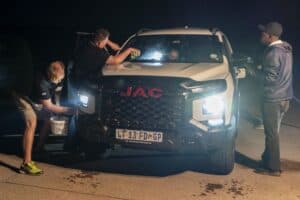Jaguar has revealed the prototype of its ‘new’ Lightweight E-type – a further six of which will be built and sold.

Jaguar announced in May 2014 that it would recreate six new Lightweights, each built by Jaguar Heritage, part of Jaguar Land Rover’s new Special Operations division.
Each of the six cars will be built to a specification originated from the last Lightweight E-type produced in 1964 and will be hand-crafted at the original home of the E-type, Jaguar’s Browns Lane plant in Coventry, England. The cars will be sold as period competition vehicles and all will be suitable for FIA homologation for historic motorsport purposes.
The new cars are the ‘missing’ six vehicles from the ‘Special GT E-type’ project, which originally started in February 1963 with the objective of building 18 cars. Only 12 of the aluminium-bodied Lightweight E-types were eventually built and the remaining six designated chassis numbers having lain dormant, until now. The six new cars will carry those original, historic Lightweight E-type chassis numbers.
The core component of the Lightweight E-type is its aluminium bodyshell. This material replaced the steel of the production E-type in the quest to shed weight – some 114kg were saved compared with the standard car.
The Lightweight E-type was powered by a highly developed version of Jaguar’s straight-six XK engine which, with its chain-driven twin overhead camshafts and aluminium head with hemispherical combustion chambers, remained highly advanced in 1963 even though it had first been seen in the XK 120 as far back as 1948.
It was this engine that had powered the C- and D-types to five Le Mans victories in the 1950s, and the unit developed for the Lightweight E-type is based on the 3 868cc engine which, in the D-type, had won Le Mans in 1957.
A similar big valve ‘wide angle’ cylinder head is used, but in place of the D-type’s cast iron block, Jaguar introduced an aluminium block for the Lightweight E-type which substantially reduced the amount of weight over the front wheels. This also features in the present-day car, with pressed-in steel liners.
The compression ratio is 10:1 and today’s car is supplied with three 45DCO3 Weber carburettors. These were homologated by Jaguar for the Lightweight E-type in addition to a Lucas mechanical fuel injection system – which is being offered to customers as a cost-option (and which is fitted to Car Zero).
Whether carburettors or fuel injection is specified, output is over 250kW, and with torque in the region of 380Nm at 4500 rpm.
The exhaust manifold is a steel fabrication and leads the exhaust gasses into twin pipes which take them through a centre silencer box to the rear of the car, where the exhaust system ends in twin polished tail pipes.








